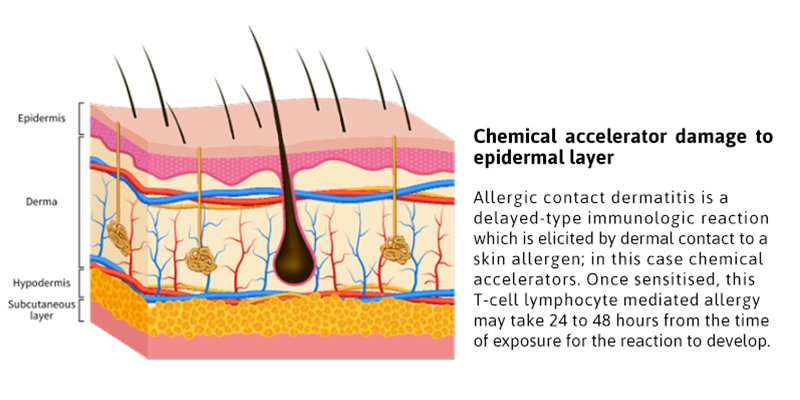Occupational skin disease, and in particular contact dermatitis, is common among healthcare workers and accounts for 90-95% of all cases of occupational skin disease.1 There are two main types of contact dermatitis: Irritant Contact Dermatitis (ICD) and Allergic Contact Dermatitis (ACD).
ICD is a nonimmune response and is a condition affecting the skin, and therefore not an allergy.2 Whilst ACD is a T-cell mediated allergic response often described as Chemical Type IV allergy is and is specific to chemical residues.2
Common causes of allergic contact dermatitis include chemicals in rubber, leather and dyes. With more than 4000 chemicals having been identified as contact allergens.3 Boudinar et al (2021) reports that Dental workers, i.e., dentists, as well as dental assistants, hygienists, and technicians, are daily exposed to a plethora of occupational allergens. 4
"One third of dentists reported symptoms of hand dermatoses in New Zealand, UK and Queensland, Australia.5"
Frequent glove use has caused the incidence of occupational contact dermatitis or adverse skin conditions to healthcare workers. These include allergies and other sensitivities, and often know the specific cause may not be known.
Rubber chemical accelerators are among the most common allergens causing occupational ACD in healthcare workers, and are found in both NRL and synthetic gloves, such as polyisoprene, neoprene and nitrile. The accelerators function is to catalyze the sulfur crosslinking reaction in both natural rubber latex and synthetic gloves to give strength and durability to the film. However, the finished product may contain trace amounts of chemical accelerators. As many of these conventional accelerators are lower molecular size, they have low solubility in the film, meaning that over time, they will bloom to the surface of the glove creating a higher risk of delayed allergic reactions.
"A study of adverse glove reactions among dentists in the United Kingdom indicated that most could be managed by self-medication, prescribed medication and/or changing to a different type of glove.5"
Rubber chemical accelerator ACD has been a major cause of occupational ACD for many years, especially among dental practitioners.5 Glove manufacturers such as Ansell have developed gloves that are manufactured without the use of standard chemical accelerators known to cause allergic contact dermatitis.
Historically, there has been little focus on dermatitis in dental occupational settings. Increasing awareness about the risks to the hand health among dental professionals and evaluating the right medical grade gloves, can help address and minimize occupational contact dermatitis in dentistry.



